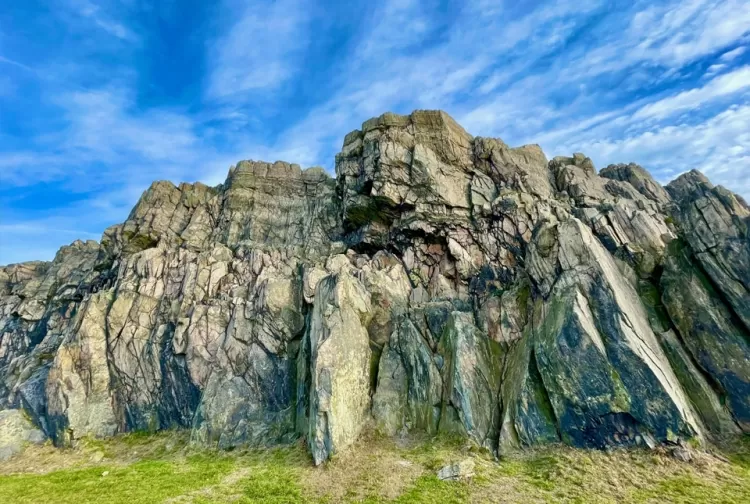Hill Rocks: Nature's Versatile Treasure...!!!
Hill rocks, often known as hill stones, are a crucial part of the natural landscape, playing significant roles in both ecological systems and human endeavors. Formed over millions of years through various geological processes, these rocks have a wide array of uses, ranging from construction and landscaping to cultural and educational applications.

Construction and Building Materials
1.Foundations and Structural Support: Hill rocks are extensively used in construction for their strength and durability. They serve as foundational materials for buildings, bridges, and other structures. Their solid and stable nature makes them ideal for supporting large and heavy constructions.
2.Road Building: Crushed hill rocks are commonly used in road construction. They provide a stable base for roads, highways, and railway tracks. The crushed stones are compacted to create a firm and durable surface, enhancing the longevity and safety of transportation routes.
3.Aggregate Production: Hill rocks are quarried and processed into aggregates used in concrete and asphalt. These aggregates are essential components in building construction, infrastructure projects, and pavements. The use of high-quality aggregates contributes to the strength and stability of these structures.
Landscaping and Decorative Uses
1.Garden Landscaping: Hill rocks are popular in garden landscaping for creating visually appealing features such as rock gardens, water features, and retaining walls. Their natural textures and colors add aesthetic value to gardens and outdoor spaces.
2.Stone Pathways: Natural stones from hill rocks are often used to create pathways and stepping stones in gardens and parks. These pathways enhance the beauty of the landscape and provide functional walkways that blend seamlessly with the natural environment.
3.Decorative Stones: Polished and sculpted hill rocks are used as decorative elements in homes, offices, and public spaces. They can be crafted into sculptures, fountains, and ornamental pieces that add elegance and uniqueness to interior and exterior designs.
Agricultural and Soil Improvement
1.Soil Erosion Control: Hill rocks are employed in controlling soil erosion, especially in hilly and sloped areas. They are used to build retaining walls, terraces, and check dams that prevent soil from washing away during heavy rains, thus preserving soil fertility and preventing landslides.
2.Soil Conditioning: Crushed hill rocks, such as limestone, are used to improve soil quality. They help neutralize acidic soils, provide essential minerals, and enhance soil structure, promoting healthy plant growth and agricultural productivity.

Industrial Uses
1.Raw Materials for Manufacturing: Hill rocks are valuable raw materials in various industrial processes. For example, limestone and dolomite are used in the production of cement, glass, and ceramics. These materials are essential for manufacturing processes that require high temperatures and precise chemical compositions.
2.Mining and Quarrying: Hill rocks are a source of various minerals and ores that are mined for industrial use. These include metals like iron, copper, and gold, which are extracted and processed for use in manufacturing, electronics, and other industries.
Cultural and Educational Applications
1.Historical and Cultural Significance: Hill rocks have been used in historical monuments, temples, and cultural landmarks. Their use in ancient architecture and sculpture reflects the rich cultural heritage and craftsmanship of past civilizations.
2.Educational and Research: Geological study of hill rocks provides valuable insights into Earth’s history, climate changes, and tectonic activities. Educational institutions and research organizations study these rocks to understand geological processes and develop knowledge in earth sciences.
Environmental and Ecological Contributions
1.Habitat for Flora and Fauna: Hill rocks create unique microhabitats that support diverse plant and animal species. They provide shelter and breeding grounds for various organisms, contributing to biodiversity and ecological balance in hilly regions.
2.Water Conservation: Rocks in hilly areas play a crucial role in water conservation. They influence the natural flow of water, promote groundwater recharge, and support the formation of natural springs and streams that sustain local ecosystems.
Hill rocks are invaluable resources with a wide range of uses impacting construction, agriculture, industry, culture, and the environment. Their strength, durability, and natural beauty make them essential components in various human activities. By understanding and utilizing these rocks sustainably, we can continue to benefit from their diverse applications while preserving their ecological significance for future generations. Whether in building infrastructure, enhancing landscapes, or studying Earth's history, hill rocks remain an integral part of our world.
What's Your Reaction?

















